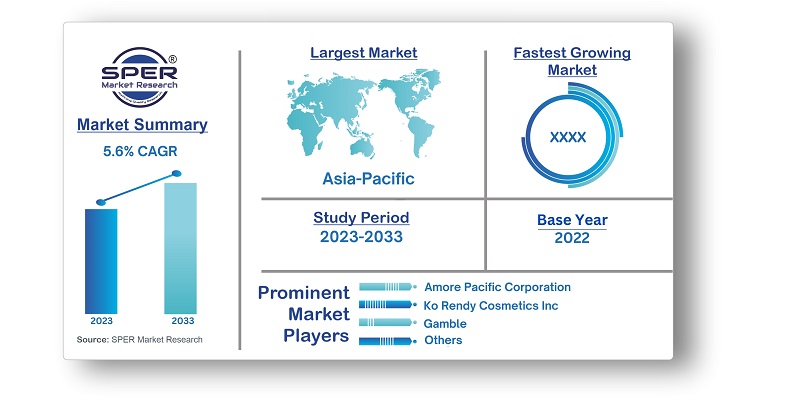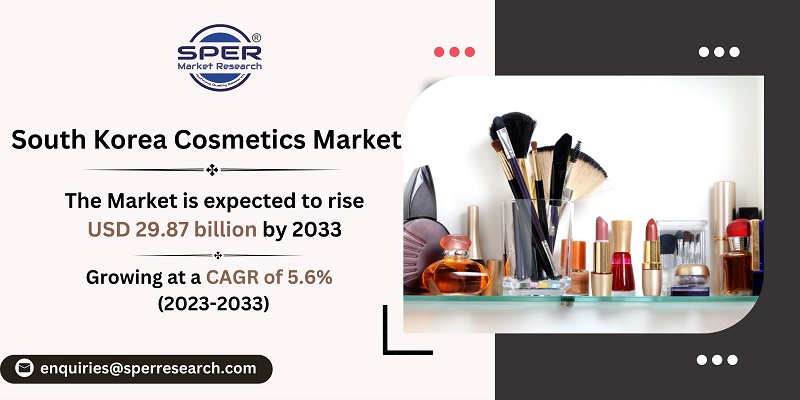
South Korea Cosmetics Market Trends, Growth, Size, Revenue, Challenges and Future Competition
South Korea Cosmetics Market Growth, Trends, Analysis, Size- By Category, By Price, By Gender, By Distribution Channels- Regional Outlook, Competitive Strategies and Segment Forecast to 2033
| Published: Jul-2023 | Report ID: FMCG2378 | Pages: 1 - 109 | Formats*: |
| Category : Consumer & Retail | |||
- Skincare Emphasis: This focus has led to a high demand for skincare products and innovative solutions, driving the growth of the cosmetics market.
- Innovative Formulations: Brands constantly introduce new and unique ingredients, such as snail mucin, fermented extracts, and natural substances, which appeal to consumers seeking effective and advanced beauty products.


| Report Metric | Details |
| Market size available for years | 2019-2033 |
| Base year considered | 2022 |
| Forecast period | 2023-2033 |
| Segments covered | By Category, By Price, By Gender, By Distribution Channels. |
| Regions covered | Seoul, Busan, Incheon, Daegu, Ulsan. |
| Companies Covered | Able C & C Inc., Amore Pacific Corporation, Ko Rendy Cosmetics Inc., LG Household &Health Co. Ltd., Procter & Gamble, Others. |
- Domestic Consumers
- Beauty Enthusiasts & Trendsetters
- Millennials & Generations
- Health and Wellness Conscious Consumers
| By Category | |
| By Price | |
| By Gender | |
| By Distribution Channels |
- South Korea Cosmetics Market Size (FY’2023-FY’2033)
- Overview of South Korea Cosmetics Market
- Segmentation of South Korea Cosmetics Market By Category ({Skin Care(Face Care, Body Care, Lip Care)}, {Hair Care(Shampoo, Conditioners, Others)},{Bath & Showers(Soap, Shower Gels, Others)}, Makeup & Colour Cosmetics, Deodorants &Fragrances).
- Segmentation of South Korea Cosmetics Market By Price (Mass, Premium).
- Segmentation of South Korea Cosmetics Market By Gender (Male, Female, Unisex).
- Segmentation of South Korea Cosmetics Market By Distribution Channels (Hypermarkets & Supermarkets, Speciality Stores, Pharmacies/ Drug Stores, Online, Others).
- Statistical Snap of South Korea Cosmetics Market
- Expansion Analysis of South Korea Cosmetics Market
- Problems and Obstacles in South Korea Cosmetics Market
- Competitive Landscape in the South Korea Cosmetics Market
- Impact of COVID-19 and Demonetization on South Korea Cosmetics Market
- Details on Current Investment in South Korea Cosmetics Market
- Competitive Analysis of South Korea Cosmetics Market
- Prominent Players in the South Korea Cosmetics Market
- SWOT Analysis of South Korea Cosmetics Market
- South Korea Cosmetics Market Future Outlook and Projections (FY’2023-FY’2033)
- Recommendations from Analyst
1.1. Scope of the report1.2. Market segment analysis
2.1. Research data source2.1.1. Secondary Data2.1.2. Primary Data2.1.3. SPER’s internal database2.1.4. Premium insight from KOL’s2.2. Market size estimation2.2.1. Top-down and Bottom-up approach2.3. Data triangulation
4.1. Driver, Restraint, Opportunity and Challenges analysis4.1.1. Drivers4.1.2. Restraints4.1.3. Opportunities4.1.4. Challenges4.2. COVID-19 Impacts of the South Korea Cosmetics Market
5.1. SWOT Analysis5.1.1. Strengths5.1.2. Weaknesses5.1.3. Opportunities5.1.4. Threats5.2. PESTEL Analysis5.2.1. Political Landscape5.2.2. Economic Landscape5.2.3. Social Landscape5.2.4. Technological Landscape5.2.5. Environmental Landscape5.2.6. Legal Landscape5.3. PORTER’s Five Forces5.3.1. Bargaining power of suppliers5.3.2. Bargaining power of buyers5.3.3. Threat of Substitute5.3.4. Threat of new entrant5.3.5. Competitive rivalry5.4. Heat Map Analysis
6.1. South Korea Cosmetics Market Manufacturing Base Distribution, Sales Area, Product Type6.2. Mergers & Acquisitions, Partnerships, Product Launch, and Collaboration in South Korea Cosmetics Market
7.1. South Korea Cosmetics Market Value Share and Forecast, By Category, 2023-20337.2. Skin Care7.2.1. Face Care7.2.2. Body Care7.2.3. Lip care7.3. Hair Care7.3.1. Shampoo7.3.2. Conditioners7.3.3. Others7.4. Bath & Showers7.4.1. Soap7.4.2. Shower Gels7.4.3. Others7.5. Makeup & Colour Cosmetics7.6. Deodorants & Fragrances
8.1. South Korea Cosmetics Market Value Share and Forecast, By Price, 2023-20338.2. Mass8.3. Premium
9.1. South Korea Cosmetics Market Value Share and Forecast, By Gender, 2023-20339.2. Male9.3. Female9.4. Unisex
10.1. South Korea Cosmetics Market Value Share and Forecast, By Distribution channels, 2023-203310.2. Hypermarkets & Supermarkets10.3. Speciality Stores10.4. Pharmacies/Drug Stores10.5. Online10.6. Others
11.1. South Korea Cosmetics Market Size and Market Share
12.1. South Korea Cosmetics Market Size and Market Share By Category (2019-2026)12.2. South Korea Cosmetics Market Size and Market Share By Category (2027-2033)
13.1. South Korea Cosmetics Market Size and Market Share By Price(2019-2026)13.2. South Korea Cosmetics Market Size and Market Share By Price (2027-2033)
14.1. South Korea Cosmetics Market Size and Market Share By Gender (2019-2026)14.2. South Korea Cosmetics Market Size and Market Share By Gender (2027-2033)
15.1. South Korea Cosmetics Market Size and Market Share By Distribution Channels (2019-2026)15.2. South Korea Cosmetics Market Size and Market Share By Distribution Channels (2027-2033
16.1. South Korea Cosmetics Market Size and Market Share By Region (2019-2026)16.2. South Korea Cosmetics Market Size and Market Share By Region (2027-2033)16.3. Seoul16.4. Busan16.5. Incheon16.6. Daegu16.7. Ulsan
17.1. Able C & C Inc.17.1.1. Company details17.1.2. Financial outlook17.1.3. Product summary17.1.4. Recent developments17.2. Amore Pacific Corporation17.2.1. Company details17.2.2. Financial outlook17.2.3. Product summary17.2.4. Recent developments17.3. Ko Rendy Cosmetics Inc.17.3.1. Company details17.3.2. Financial outlook17.3.3. Product summary17.3.4. Recent developments17.4. LG Household & Health Co. Ltd17.4.1. Company details17.4.2. Financial outlook17.4.3. Product summary17.4.4. Recent developments17.5. Procter & Gamble17.5.1. Company details17.5.2. Financial outlook17.5.3. Product summary17.5.4. Recent developments17.6. Others
SPER Market Research’s methodology uses great emphasis on primary research to ensure that the market intelligence insights are up to date, reliable and accurate. Primary interviews are done with players involved in each phase of a supply chain to analyze the market forecasting. The secondary research method is used to help you fully understand how the future markets and the spending patterns look likes.
The report is based on in-depth qualitative and quantitative analysis of the Product Market. The quantitative analysis involves the application of various projection and sampling techniques. The qualitative analysis involves primary interviews, surveys, and vendor briefings. The data gathered as a result of these processes are validated through experts opinion. Our research methodology entails an ideal mixture of primary and secondary initiatives.



Frequently Asked Questions About This Report
PLACE AN ORDER
Year End Discount
Sample Report
Pre-Purchase Inquiry
NEED CUSTOMIZATION?
Request CustomizationCALL OR EMAIL US
100% Secure Payment






Related Reports
Our Global Clients
Our data-driven insights have influenced the strategy of 200+ reputed companies across the globe.




















